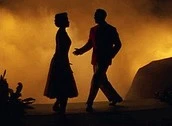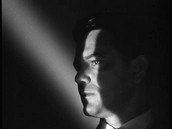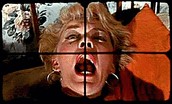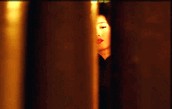 Copyright © 2010 by James Clark
Copyright © 2010 by James Clark
Regarding the reception of her Anatomy of Hell (2004), soon after the shooting of which she underwent a major stroke, from which she has recovered, Catherine Breillat remarked, “I hope they won’t kill me.” She might have found solace in the fact (undoubtedly known to her) that Ingmar Bergman presented the same incendiary zone in his Cries and Whispers (1972), and went on for decades thereafter. Of course the latter had chosen a discreet embodiment of the concern, embossed by a drop dead cinematic elegance more than ample to quell any mutinous inclinations from the customers. Breillat, bless her, came to the party with porn lightning rod, Rocco Siffredi, and a scenario bristling with pugnacious outrage—and so much more!
Bergman embarks on his discovery, with steady, crystalline ticking of a clock, tapping upon the exceedingly well-groomed grounds of an estate in early morning diffuse light. He then proceeds to the interior of the villa and a sleeping woman restlessly deposited in bed, awakening (with red-rimmed eyes and nostrils) in startlement, and then invaded by a death-tinged realization, her eyes and mouth fighting panic but unable to dismiss the throbbing of a perpetual grief. Breillat, too, opens with insistent sounds, specifically techno-pop issuing from a dance club in the night. Outside, whereas Bergman showed a sedate stone statue of an angel with a lyre, the latter work shows a man sucking another’s cock. Inside, there is an all-male festivity going full-tilt, all but for a dark and attractive woman, who, after watching impassively for a while, makes her way sombrely toward a washroom, in the course of which bumping against another patron, who is acute enough to detect and care about the danger she exudes. He finds her slashing her wrist and rushes her to a clinic.
Each of these films centers upon a woman in dire straits, and those drawn into attending to her. Each of the narratives concentrates upon a remarkably daunting consequentiality of one’s physical attunement. Whereas in the Bergman piece the center of attention is in the palliative stage of pancreatic cancer and her raging physical malignancy disposes her energies to responses to the attentions of her two sisters and a servant, the latter three becoming thereby the testing ground for managing a vast wherewithal of sensual affection, in Breillat’s film the protagonist—readily shaking off her bloody faux pas—is all about that wherewithal and how to bring it cogently onstream in conjunction with an attentive associate, likewise under the gun.
Though extremely dissimilar in details, the virtually one and only setting for each history functions, in both cases, in accordance with the dilemmatic weight of physical presence. The cries and whispers of Bergman’s project infuse a nineteenth century moment graced with sumptuous eighteenth century decor, swathed in spacious, blood-red rooms. The hell-raising of Breillat’s project plays out to a once-grand, spectacularly located manor—having received perfunctory modern lighting and plumbing—now marred in particulars by the years, but thereby (with its generous dimensions and coherently faded appointments) paradoxically providing a level of frisson. Before Bergman’s protagonist, “Agnes,” becomes conscious of the new day and its old horror, we are given a tour of her bedroom, especially its timepieces, in close-ups that allow us to appreciate their sensuous qualities, their rounded shapes, some with glowing metallic textures, another with a wooden clock face the demarcations of which feature painted lines of quiet chromatic resonance, and a licorice-like second hand, slowly slicing forward. Then we see a precious metal figurine, an angel in burnished overlay, looking through a spyglass. Agnes, now awake and ruled by her decay, walks with difficulty to one of the clocks and turns it back somewhat. She opens a curtain and glances at a pond and its park, and then she turns away, having, instead of a joyous lift, derived a mockery of her incapacity to enjoy it. She writes in her diary, the creamy paper in the morning light and the nib with its cargo of ink shown in minute detail. She writes, heedless of this little physical treasure before her, “It is Monday morning. And I am in pain.” But later in the day, rallying, righting herself, she touches and ponders quite peacefully a bouquet of white roses, and later still we see she has worked on a watercolor of one such gift. That cadence of refusal and rapture extends through the actions of her care givers, and provides the work with its boundless subtleties, and almost impossibly dark beauties. There are only two features of the less refined room that rise to the evocative density of that where Agnes lies. There is a heavily oxidized, ancient mirror, and it allows the anatomist to be checked in upon by her estranged paramour, who proceeds as a lesser Bête (Beast). Accordingly, there are mismatched lamps strewn about, to mock in view of the surrealist electrodynamics of La Belle et la Bête’s sharply uniform lighting.
Breillat, for all her reputation as a bull in a china shop, proves to be a very serious match for Bergman’s eponymous refinement. Her assimilation of Cries and Whispers (as with Beauty and the Beast in Fat Girl and Pee-Wee’s Big Adventure in 36 Fillette) is far from straightforward, having nothing to do with insider mimicry. She splinters the functions of the extensive, long-ago players occupying that Scandinavian mansion and redeposits them in the actions of the duo holding forth in present-time at a distress-sale ruin on the outskirts of Lisbon. One such surgical transplant entails Agnes’ older sister, “Karin,” whose marriage to an acidic lawyer in the diplomatic corps comes to such a head of poison that she propounds to herself, “It’s but a tissue of lies. A monumental tissue of lies. All of it!” and, on angrily snapping the stem of her hyper-thin, brilliant wine glass at the dinner table with him (sometime in the past, seen in a flashback), a fixed scowl on his gaunt, puffy-eyed visage and dead-eyed consumption of his Bordeaux, she carries a shard back to their bedroom, spreads her legs and slashes her vagina with it, and greets the great man with a hard smile, smearing her face with the blood, and drinking some of it. Both the actress playing Karin, Ingrid Thullin, and the razor-wielding venturer of Anatomy of Hell, Amira Casar, are dark-haired beauties, with high cheek-bones and sensual mouths, and Breillat knows exactly what to do with that kinship.
Karin’s real work at the lugubrious juncture where we encounter her is to absorb the overture of her youngest sister, “Maria,” on behalf of eschewing vengeance and becoming “friends.” “We could put our arms around each other, devote these days to getting to know each other.” Karin—who had been included with her husband as “pursuing a diplomatic career [of calculative correctness]”—has in fact imbibed such a welter of ascetic ballast that she ferociously counters Maria’s easy caresses with, “Don’t touch me!…I don’t want you to do that!” On the young woman at Lisbon’s leaving the clinic and turning the corner on a minor medical crisis, the attendant envisages her slashing her throat as an encore and shows some persistence in keeping in touch. She asks, “Why did you follow me to the toilets?”/ “You touched me as you passed by…It was touching…Then I got scared. I was sure of what you were doing.”/ “You just wanted to be sucked, like all men.”/He slaps her face and says, “Dumb bitch!”/ “You’re all alike.” They walk in the dark along a river promenade. He asks, “What do you want to do now?” She considers this question at length, looking into his face with a tight determination. She undoes his fly and sucks him. He is overcome; and then she stands up, her mouth full of his semen. “I’ll pay you,” she says, after catching her breath. “Why?”/ “To find out how you understand women…to look at me when I can’t see myself…Just tell me what you see.”
The nameless night owl does not share Karin’s aversion to being touched, but she extends her predecessor’s anguish, beyond fuming about the tissue of lies propping up world history, to an upshot of the concomitant war between those, like the diplomat, finding lies sufficient, and those, like Karin (and her), completely unimpressed. She has contracted her ambivalent benefactor to visit her on four consecutive nights, the better to find out how the cookie crumbles. The first night, he starts out by grumbling that hers is “an isolated house” (on a cliff by roiling ocean waves, a massive surf charging in), an expensive pain in the ass to get to. She counters with, “I’ll pay for everything,” and tells herself, “It sickens him to be here. He hoped for something new, unexpected. Though he knows it won’t be.” She excuses herself to go to an ensuite bathroom, and her body function can be heard. Such a gambit is part and parcel of the film’s most elusive aspect, namely, its only apparently setting up a facile confrontation between man the deracinated aggressor and woman the integral victim. Though endowed with the instance of Karin offsetting the puerile notion of an angelic entitlement for women, the impresario of the four-night fest insists on couching the drama in terms of a miserable world-historical interplay between men and women. (She is somewhat provoked toward that distortion by her inductee’s being a habitué of gender exclusivity, and being an almost uncontrollable male chauvinist rhetorician.) But it is well to recognize, through the ensuant stream of oracular insistence, that that interaction has been launched on an impromptu basis, coming out of suicidal despair, and that she clearly has discoveries and improvements to make. (A little tipoff to this effect is her finding him to be “early” on the first night and so finding herself to be not well prepared, needing to rush to the bathroom and being dressed in a fusty bra [nodding toward the horrors of Karin’s underclothes] so ill-fitting as to leave marks on her shoulders and back. No amount of extra time that day could have done anything about the hodgepodge of her decor, nasty ill-matched little lamps everywhere, dirty walls and thoughtless acquisition and arrangement of all the other furnishings.)
On removing her clothes and lying upon a rather fragile-looking brass bed, she puts into play near-perfect proportions and pearl colored, perfect skin. The man’s observations have nothing to do with this empirical fact, but swirl into play from recesses of dogmatic militancy. “The fragility of female flesh inspires disgust or brutality.” The woman swings into her own aphoristic lament (including, by contrast, some sane content). “It takes ages between the offer and the demand…Thereafter nothing flows. All is fake [my italics]…artificial catching up…the clumsiness of hasty brutality.” The guy hopes to explode such la-de-da imposition with, “You talk too much. Your words are inept reproaches.” She counters by silently and languorously stretching out her formidable body and opening her legs to him. He ungenerously declares that even if she were to shave her armpits and her “crack” the “obscene nature” of her flesh would obtrude, in “lumpy,” sore-like tiny pebbles of damaged skin, “a skin that sweats, oozes.”/ “So we can’t do a thing?”/ “No. A woman’s body is “the depth of obscenity.”
Anatomy of Hell fortifies itself in erotic physicality of so forceful a nature that its interpersonal, historical drama tends to go missing amidst its tissue of violent shock and violent talk. As her rescuer enters the club’s bathroom, the floor of which would be receiving some unwholesome soiling, he calls out, “Why did you do that!?”/ “Because I am a woman.” While the midst of suicidal haemorrhaging is far from an ideal standpoint for lucid discourse, we can, if we look beyond the delirious momentum, notice aspects of the eventuation bizarre and compelling in their incongruity, and truly unique daring. There she is, the only female on the premises, wanting to lead one to believe she has a vital affinity with her gender. The narrative provides not a shred of evidence that she has any more connection with women than she has with men, let alone homosexual men, in their putative, demonstrative and vastly overrated iconoclasm. The treacly, sisterhood pap she kicks off in the club’s toilet derives from reasoning at the level of humanistic conventionality—which her every move indicates she is totally estranged from. (Just before she lowers her bra while undressing that first night, he asks with asperity, “Why do you exhibit yourself in this way?” The audacity of her bid, as opening a vein of intercourse disorienting to not simply parochialists like him, impresses this unnervingly unique wildness and volatile refinement in a manner precluding anything resembling rational disclosure as hitherto experienced.)
At the end of Cries and Whispers, Karin has come to assimilate Maria’s overture—“It seems I’m in a dream. An event of great importance is upon us.”—at a level the latter had never stabilized. (After the initial rebuff, Karin had pulled herself together to reach out to Maria, and, in a sublime episode, the women’s faces are shown in close-up, “speaking” ardently and joyously with no sounds but the pulsing of a cello motif, caressing each other’s forehead, cheeks and mouth and riding a wave of loving dynamic, originating both within and beyond themselves.) She takes Maria aside in the swirl of evacuating her now deceased sister’s property—a decampment wherein she had cruelly led the charge dismissing Agnes’ loyal servant, “Anna,” to the chagrin of Maria’s discernment, however fleeting and truncated, that more generosity was called for –and she implores, “Could we hold to our resolutions?… You touched me. Don’t you remember that?” Maria’s face turns hard, beneath its fixed smile. “I never recall stupid overstatements. Never try forcing me to account for them. What do you want?” Karin, the sense of the full monumentality of the lies she is up against dawning as never before, vacantly replies, “Nothing.”/”Keep well,” smirks her sister.
The presence of the lady by the cliff, at the electro agitation, comes to us as probing a contrarian power source in its will-o’-the-wisp contrariness and clan solidarity, and being impressed by its fakeness as compounding an already savage travesty. Her coming to a fortuitous and brief partnership with the promising volatility of her antiheroic rescuer emerges by way of that exploration of the contours of the disaster that was in fact at the basis of her play with the razor.
Karin, over dinner with Maria, before (briefly) surrendering herself to a transcending love, admits to a sense of physical incompetence, clumsiness. “My hands are too big.” She laughs, and then cries. “I often have thoughts of suicide… It’s very degrading… Do you realize I hate you and your childish flirtations?” (Maria has a chequered history with the doctor treating Agnes, a moment of which resulted in her husband’s attempting suicide.) “For me, there’s no relief, no charity…Nothing can escape me, for I see it all… Now you know how it sounds when Karin speaks.” That grotesque self-assertion is promptly and sharply given a fitting downgrade by Agnes’ death throes, her gasping and squealing like a sick beast, mouth agape, which galvanize both Karin and Maria to a blithe, gentle caring and comforting in her final moments of respite before obliteration.
In accordance with that terror-driven deflection, Breillat’s own voiceovers, for the reasons (causes) of the impasse, perform, in addition to an evocation of the compromised state of the sexist dogma regarding the transaction, an enactment of the thrust of misrepresentation that nearly every remark here has been infected with. Helping us avoid getting waylaid in some journalistic donnybrook about who’s tops, Breillat accentuates the idiosyncratic nature of the man’s anxieties, a manoeuvre contributing to our realization that the woman’s recriminatory screed about gender is a function of that self-defeating misstatement intrinsic to the historical crisis with regard to which she has staged this moment of truth. The director’s ushering us into a formative trauma in the man’s boyhood (Bergman had used voiceovers to introduce flashbacks revelatory of Karin and Maria) activates his confession that revulsion toward the wet, matted vaginal area traces to an incident of raiding a nest of newborn chicks, killing one and smashing it underfoot. Pinpointing such a moment to make sense of a position like, “The fragility of female flesh inspires disgust or brutality,” in fact dances around the heart of the conflict placing the impresario so close to suicide. That protagonist (after adding to the jeopardy of a war between the sexes, by insisting, “I control my impatience. The waiting has become part of the pleasure.”) sleeps through this reverie, her labored breathing in the context of close, prolonged observation conjuring Agnes and the posted deathwatch.
The first night had begun with his reiteration that, “all you can ask me to do is observe,” and her smiling wryly and saying, “But I can still hope for more.” There is a mottled mirror in that nocturnal domain, and as he peers into it, observing her radiant body, we are reminded of Bête’s keeping track of Belle courtesy of a surreal mirror (the surreal being the “more”). Accordingly, she undresses like Alice (for Mr. Eddy), in Lost Highway—removing the straps of her bra, one by one, that little pause, and becoming ready, come what may. On beholding his white suit and authoritative glance she could be excused for wondering if she’d allowed some kind of missionary, or mechanic, to get a foot in the door of her torrid zone. “Your denial of the obscenity of your flesh is what frightens and disgusts us most.” She taunts, “It’s late and you still know nothing about women… Come close.” But change is afoot; and this is arguably the moment whereby Breillat’s endeavor supersedes that of Bergman. He goes to the fridge for ice, and then shows some candor on which the “more” could catch fire. “Why do people drink when they’re together? Because they have nothing to say. We drink because there’s no communication. Nothing.” At this point, Breillat conducts a second tour through childhood—the woman’s—wherein, to break the ice with some little boys, she proposes playing “doctor,” with herself as the patient. She imagines those budding medics being “disgusted forever” by the sight of her little body. That digression, which might only confuse matters, becomes subject to a jet stream (an ice-breaker) bringing the two of them into a confused but touching confluence. Fortuitously apprised of his own best interests by the bourbon, he comes to the bed and with a finger takes some fluid from her vagina. After more such probing, she giggles, perhaps as she did as a little girl. “I bless the day when I was born immune to you,” is his stuffy cover for increasing attraction. “Look at me where I can’t see myself” is her healing-intent rejoinder to such flimsy incantation. He leaves the building and becomes washed over by the buzz of little nocturnal beasts and by the spectacle of a furious sea. The voiceover, for once on the right page, vocalizes his recognition, “I felt trapped by a kind of sorcery [a kind of surreal bite]… the obscene signs of nature…helpless against the world.” On returning, he goes to the bathroom, finds a lipstick (blood red) and (with a Daliesque flourish) applies it to the lips of her vulva. She is “asleep,” oblivious to [or steadfastly beyond] his studiously hostile approaches. Then he applies it to the lips of her face, illuminated by a small lamp he directs with his free hand, smearing it in such a way as to leave her clownish, but, notwithstanding, even more ravishing in her celestial poise. The arch-enemy of women is next seen nude, penetrating her paintedness from behind and making love to her, his very powerful torso crushing her from above with each pounding thrust from below (she still not alert to a windfall buffeting her, here in the form of “more,” but, in lower key reflection of his heaving body, loud gasps and tensing mouth). Her groggy participation is not without charm, and no one is more aware of it than he—a situation too destabilizing of his rational fortifications to be borne with grace. His muscular body humbled thus, he weeps, his nose runs, and she finally stirs to half-consciousness. She shuffles down the bed to comfort him. “It doesn’t matter. It’s just the first night.” She, very sleepy and squinting in the bright light, takes his arm and puts it around her; she places her face against his chest and touches it gently with her hand. And there they lie, in caring intimacy, as if they had been an item for some time.
As it happens, that night was only too unique. He had nearly succumbed to an uncanny timbre (“sorcery”) and, canny foot-soldier that he was, the next night he was fully armed to wreak revenge upon the centre of impiety she represented. We see her in a little black dress and red high-heeled shoes (like Alice’s, that night she tried to impress Eddy, the telling of which horrified her young, but old at heart, new boyfriend), seated on the toilet, smoking. On his arrival, she rushes to the door and smiles at him with anticipation. Now there is a red bedspread, which she sprawls back upon, after having her carefully combed hair peremptorily unpinned by him and being abandoned while he headed for the bourbon. He comes to the chair and scowls at her, she having once again fallen asleep, that is to say, having desensitized herself against readily perceived resentment. He, too, sleeps, at her vagina, and as he wakes up a crucifix dangles from his neck. He spreads her hips as she lies, face down, checks the orifice, smells her, and we see a crucifix on the wall over her bed (the sheen of its surfaces reminding us of the clocks and figurines in Agnes’ room). He touches her and discovers menstrual blood, tastes it, goes to the yard for a short-handled hoe with a trident head (recalling a pagan sea god, or goddess), returns and slowly plunges it into her. She gasps but does not awaken, and it lies planted there. She opens her eyes and looks with equanimity at her assailant and her impalement. Then he is in the chair, the bourbon nearby; the hoe is on the floor, and she is sitting up, sadly, but with undiminished poise. He is asleep, and when he awakens she says, “Last night you wanted to kill me. You fought that urge a long time… What all men feel… But you don’t fully know the danger you could do.” After that unseemly rout, things taper off to civil and domestic banality, as stanching terminally malignant hysteria. Third night, and he enters through a front door left wide open; he is without his crucifix, and he snaps at her, “Anyone could have come in.”/ “Or anything.” This latter remark finds her effort, as to “more,” entering a zone of stunted contradiction with a view to bathetic advantage. She is nude; he is in his clinician’s garb. She judo-manoeuvres him under her on the bed, and delivers a lip-smacking account of male violence toward the weaker sex. “That’s what men can’t stand…the spell of women…In fact they’re afraid we don’t belong to them…They threaten us with belts, padlocks…their foolish morals. They need proof of love; but then love has no meaning…They don’t believe in basic freedom.” Then, both sitting up, like a fastidious young couple with plans stretching into a comfortable middle age, she gives him a lesson on tampons, holding up a bloody example and intoning, “See. That’s all there is to it. Because of the blood they say we’re impure.” She drops the used tampon into a glass of water, and they, with solemn demonstrativeness take turns drinking the didactic cocktail. “Don’t we drink the blood of our enemies?” As if that drink between these two spouses (no less avid for being temporary) had gone straight to her head, she becomes unnervingly maudlin. “In fact, men never understand us. They fear us, like kids in the dark…Our protector doesn’t like us” (and she is in tears). The self-consciously rational young moderns conclude their meeting with her asking him, “Did I lose all my dignity, doing that in front of you?” He does not reply. Each of them approaches their final night of discovery with vastly diverging renditions of the dignity or sufficiency of the calculative turn. He would find the truce illuminating a hitherto unthinkable avenue. She would see viability in such tedium, as a hellish tool for scabbling an obdurate crudeness. Now at a jarring level of placidity, both of them nude on the bed at the outset, her foot fashionably resting on his chest, there is, to begin, a bit of suburban raciness whereby she pops out a dildo and insists, “The only thing giving me pleasure with it is the movement of your hand upon it.” He reinserts the mechanism and her face is jolted to a state of eyes deathly wide, as were Agnes’ eyes during her disease’s final march. He penetrates her and there is strenuous and prolonged rocking (a sort of honeymoon moment), he gasping fiercely after the ejaculation. He gently caresses her face and kisses her. She kisses him and caresses his chest, and then we see that her vagina pours menstrual blood and that it covers his cock. That bit of visual shock trips them back to the diplomatic range of armed standoff. “It’s beautiful. You look like you’re bleeding. This haemorrhage is from the fertile blood of women…You worry that I may have cursed you, ruined your penis forever by my blood.”/ “Right.” To bring down the curtain on this four-day battle, there ensues a bit of logic chopping apropos of his having no problem with fecal matter collateral in sodomy. From a distance we see him leave and we see her close the door. Breillat speaks for him: “By keeping the money, I exited from the myth. I lost her.”
The last movement begins with his complemented remark, while still on the unkempt grounds of her home, that the wad of cash she has affixed to him plays a part in this entire incident’s having caught him “off guard.” Then he is at an all-male bar, reciting to an elderly drunk that he’d performed with brilliant ruthlessness toward an incomprehensible bitch. “A human being wouldn’t let herself be used like that.”/ “You’re right. She was a bitch and a slut.”/ “But she was the queen of the sluts.”/ “You’re immunized against all that…You let one get under your skin, you’re fucked…finished…You can get drunk. They can’t take that away from you.”/ “I made her crap her shit, wallow in her piss. But she always wanted more…I should have ripped her guts out.” After a while he’s crying. “I don’t even know her name…I really knew her…I experienced total intimacy with her.” Then it is morning; someone is cleaning the bar; and, through a window from within, we see him dragging himself to his feet from the gutter where he spent the second half of the night. He returns to her house, now vacated (as was Agnes’ place). The voiceover would have him say, “I wanted to start all over again. I didn’t want to believe that life wasn’t like that [securing a loot bag]. I refused to believe what she gave me was mine now [to struggle with and for, for the duration].”
(That final instalment of the device of the writer/director’s intrusion into the tangled affair [with its nuanced definiteness about a problematic course that chills the blood] clarifies, I believe, the often wayward input. So dangerous and slippery to the touch is the delivery of this film, as depicting thoroughgoing skepticism about the spiritual and intellectual history of the world, that the dramatist has felt compelled to come, in a certain sense, before the camera and enact the instability in ways complementary to those of the featured players, and articulate the unprecedented problematicness.)
At the abandoned house, there is a bloody sheet, just as what was left in Cries and Whispers was Agnes’ diary. The electro returns. Its comforting simplicity (in fact, the piece is called, “Timeless Bass”), supplementing the burden of the alcohol in his system, puts him into fantasizing fighting the good fight against infidels, wherein he pushes her over the cliff at her former whereabouts. (The final shot has him Byronically posed at the cliff’s edge with the explosive ocean at work below.)
She’s in that ocean alright; but she hasn’t been killed off, being much more rigorously (which is quite a different thing than perfectly) built than that hunk. As with Alice, in Lost Highway (Breillat’s favourite Lynch movie), she’s out there. The one-out-of-four isotope yield in her trial run would provide a lot to work with. Such a line of drama has been given a final jolt by the presence of the narrative of Cries and Whispers.
There is a passage, in that latter film, that also deploys fantasy to take a reading of the players’ heart. The three care-givers who have much more on their plate than their sister’s demise, lock into the memory of an Agnes whose corpse awaits burial. Each has spent a significant part of her life with Agnes, and the pressures of going forward with gusto induce each in turn to assess her investment. The reveries take the form of an Agnes needing one last outlay of love to help her to “sleep,” and summoning them to her corpse to deliver the goods. Karin slugs her with, “Perhaps if I had loved you I’d want to help. But I don’t love you.” At the thought of Agnes’ being dead, Maria recoils hysterically. Only Anna, Agnes’ maid (and her true sister), carries through a loving consciousness, getting up on the bed, gently holding the ruined body (as if it were Christ brought down from the cross; the bloody sheet the observer finds on returning to the battleground on the fifth night thereby touches upon the Biblical incident in its being delicately superseded) and providing her tormented face with the comforts of her warm breasts, as she did when her mistress was an invalid. At the end of the film, Anna has been dismissed (with a diplomatic civility far more vicious than a prompt firing would have been) and her severance gift is Agnes’ diary. The film ends with her reading of a day when the four of them walked those magnificent grounds and came to a swing where the mood was light. “I could feel the presence of their bodies, and for those few moments I experienced perfection… Come what may this was happiness, and I feel profoundly grateful to this life.” Throughout the film, we see Anna at a little altar she’s set up in her cramped quarters, confiding to it her resignation about having lost her child to tuberculosis, and how grateful she is to have lived.
This antipode of cool—whose face was slapped by Karin, in the course of undressing her for bed, and being ordered, “Don’t look at me!”—as far from a stud as you can imagine, does represent that narrative’s traction for the “more,” the cutting edge. As such it has been factored into the sexy anticipations of Anatomy of Hell, tempering its desperation about sustained perfection, and refreshing its love.
Anatomy’s observational, analytical format and its trivializing, downward trajectory from the first night demonstrate the havoc done to a vital and delicate lifeline (or ground, or cause, or reason) by the truncated reasoning on which civilized history rests. In declaring to his drinking buddy, and fellow-escapist, “I should have ripped her guts out and made her eat them,” the muscular fantasist presents himself as little more than a cave man, far from a voyager into “something new.” His painting her vulva produces a chromatic thrust akin to cave paintings upon honey hued walls. His wordy, ascetic revulsion and violence re-enact the coercive efficacy of clannish conventionality. This capacity for totalitarian cleansing—which has been alluded to in the seemingly feeble squib, “They don’t believe in basic freedom”—is very much on Breillat’s mind in the extensive interview by which she supplements the DVD version of her film. “Terror can create hatred,” she declares, and goes on to shudder that, while it is fair enough to hate her work, she has been seriously hurt by the fact that the disgruntlement has taken the form of hating her personally. Not only would this shock of onrushing isolation and injury contribute to her imminent stroke; the extensive “clarification” of the documentary comes to comprise a sad exercise in damage-control.
Breillat’s gambit is to perform a quick sketch of the combative nature of the dynamics of consciousness, and from there to emasculate its harsh facticity. She states that “denial” is the central theme of Hell. The film shows “a confrontation of two natures,” touching upon the fact that “we don’t want to express the unconscious.” The woman is a femme fatale, “one who makes men fear they’ll lose their bearings.” But sensuality such as hers “makes us conscious that we’re unique individuals;” it is “about being uplifted.” What is withheld here is that the “being uplifted” in question comes with a huge price tag upon resources of courage. (A phrase like, “Weakness is stronger than strength because it leaves room for thought,” conveniently [in the sense of this bit of politics] embraces the perishable and sublime composure of actress, Amira Casar, in face of a floundering and conflicted brute, brilliantly portrayed by Rocco Siffredi, a composure infused by a kinetic poise, a dancer’s capacity to invoke being drastically finite.) That is the nub of the vitriol which the artist hopes to assuage, by insinuating that her sense of “uplift” is right up everyone’s alley, is in fact but a quirky adjunct to mainstream humanitarianism. “When we have feelings, obscenity disappears.” (To make that hypothesis fly, the term, “feelings,” has to be defined in such a way as to precisely drive most of the population into a dismissive rage.) The register being exploited here is that of off-to-the-races feminism, which adopts with complete nonchalance Old Testament militancy to supposed earth-shattering, innovative consequences. “There’s no pleasure in this film. It is impossible to find pleasure in humiliation and domination.” “We are an evolving species… I think, therefore I am.” This Cartesian giddiness feeds into the running-for-office rhetoric, “a nation of lovers who identify with the transcendence of the sexual act…We can find ourselves by being lost.”
Breillat has produced a work for the ages, if only we can get past the dicey surface, and her understandable misrepresentation.
























 Click on names for archives
Writers/Founders
Click on names for archives
Writers/Founders
“Each of these films centers upon a woman in dire straits, and those drawn into attending to her. Each of the narratives concentrates upon a remarkably daunting consequentiality of one’s physical attunement. Whereas in the Bergman piece the center of attention is in the palliative stage of pancreatic cancer and her raging physical malignancy disposes her energies to responses to the attentions of her two sisters and a servant, the latter three becoming thereby the testing ground for managing a vast wherewithal of sensual affection, in Breillat’s film the protagonist—readily shaking off her bloody faux pas—is all about that wherewithal and how to bring it cogently onstream in conjunction with an attentive associate, likewise under the gun.”
This is as studied and brilliantly posed a comparative essay as I’ve ever read. Your complete dedication to the thematic similarities here is what makes the study uniquely comprehensive. Sorry to say I have not seen this particular Breillat, though I am a big fan of her work (BLUEBEARD is one of 2010’s most distinguished films, and for me THE LAST MISTRESS is a masterwork). CRIES AND WHISPERS on the other hand is a film I’ve adored since I first saw it in a Manhattan theatre in 1972. It is one of Bergman’s supreme masterpieces, a metaphorical tour de force that compellingly uses the color red to inform it’s thematic underpinnings. A quartet of electrifing performances inject the film with a searing quality that builds in intensity until the magnificent conclusion. Harriet Anderson in particular chills the bone marrow as a woman dying of cancer, who penetrates the vaneer with some haunting revelations. Pictorially it’s as exquisite a film as Bergman has ever directed, and as you assert (particularly) with ANATOMY OF HELL it’s erotically charged.
I’ll never forget one of my friends, who walked out during that glass/vagina scene.
Thanks, Sam.
At first blush one wouldn’t imagine much in common between Bergman and Breillat. But she has gone on record as regarding Sawdust and Tinsel as one of the biggest films ever made, a somewhat odd choice when approaching the mountain range of dazzlers in Bergman’s history. But she does very well embrace colleagues who, like her, never observe the rules of the road.
Like you, I’m blown away by the elegant daring of Cries and Whispers. I concur with your assessment that the stars of that film display unique alertness and nerve. When you do see Anatomy of Hell, let me know if you see a similar selfless dedication in the work of Amira Casar and Rocco Siffredi.
Poor James will now have the moral police after him. I remember when I had the temerity to show a bare nipple in a still from Hani’s Inferno of First Love I received complaints. Bloody fools!
Allan, as you well know, we have to keep the patience-pump constantly in play.
Last night I saw Pulp Fiction for the first time (I am that slow!), so I’m still on an arc of outlaw fun.
if you want to see the moral police out with batons check Allan’s piece for the 90’s on PULP FICTION.
I planned on covering ANATOMY OF HELL for my extreme series after the Horror countdown concludes, but I don’t have to now. Brilliant work here. It’s still my favorite Breillat that I’ve seen (i’ve only seen 4 or 5 of hers), though BRIEF CROSSING is also sublime.
Though I just recorded THE LAST MISTRESS of my free ondemand service so I’ll be seeing that very, very soon. I still haven’t gotten to buying FAT GIRL but I want to.
Thanks,Jamie. Your enthusiasm for Breillat is a treat.
And wow, I’m a bit surprised to hear there’s been so much grief for Allan from certain Wonders readers. I guess the stuff I do is so not them that they never even notice 🙂
Well I’m deeply deeply offended Jim. Showing the human body like that is extremely unnatural. I would hope that you refrain from such blatantly disruptive behavior in the future. Two hours of Disney channel programing should do the trick. As for your piece I must say it is very fascinating. I need to see Cries And Whispers again and Anatomy Of Hell for the first time before I can really chime in. Regardless I look forward to rereading this piece when those films are fresh in my mind after a viewing.
So long and Miley Cyrus isn’t on, tons of Body objectifying there (and it’s underage to boot)!
I’m really pleased, Maurizio, that you’re going to look into this.
Incidentally, I thought of you and the other music enthusiasts while watching Pulp Fiction last night. That soundtrack does so much for it.
It might make more sense of Tarantino’s being such a fan of Wong Kar Wai.
Oh Jamie, who will bother to search for Allan’s piece. Here is the link: https://wondersinthedark.wordpress.com/2009/11/10/pulp-fiction-no-26/.
The only baton I have ever held is in a relay. Though I have been on the receiving end – back in the the days when young people actually took action.
What I find most interesting about this essay is that Mr. Clark has paired two unlikely candidates for comparison. True, Cries and Whispers makes the strongest case, and yet an essay can also be written on each in the way they stand alone.
Anyway, a great read.
Yes, I agree… I’ve spent a few minutes trying to think of a third film he could add to this comparison. And while some are easy (THE IMAGE would work great, so would ANTICHRIST), it would be fun to add a film that isn’t that comparable at first glance, but then IS. Off the top of my head I can’t think of anything but Lang’s BIG HEAT.
An unlikely film where the trajectory is close to that of those first two would, I think, be Fellini’s 8 1/2.
yeah that’s a good one two. Either way I really look forward to your next piece, I love you style.
You’ve gotten me to revisit ‘ANATOMY OF HELL’, I’ve added it and bumped it to #1 on my netflix. I can’t wait.
Glad you liked it, Peter.
I really enjoyed following Breillat in her touching upon Bergman’s bourgeois drama with the actions of her barely historical protagonists. In her best work, she brings novelistic subtleties into seemingly reckless screenplays.
I won’t buy into the merits of Breillat’s film, but I do think there is an anomaly in her sexual politics. Projecting the psychopathology of the protagonists as some sort of critique of male oppression is problematic. Try telling the woman in your life that the deepest sexual perversions are liberating, that anal penetration is really fun, and that if she throws something at you she is oppressed…
jeez, you paint in some broad colors.
No broader than Breillat herself [my emphasis]:
“In the scene in the bar he describes sex in the ugly way it is presented in pornography –he says he fucked her, and then he turned her over and fucked her up the ass– with no emotion or love attached to the act of love-making. It’s the way all men talk about sex, and also all the censors and religious creeds that teach us it’s an abominable act. But when he realizes that the vulgar terms he’s using are a lie, he begins to cry. He doesn’t even know her name, yet his sense of loss is overpowering. This is what making love is about, and the depth of his emotion is a revelation to him.”
So, it would appear she’s using satire, perhaps?
No:
“I have both been praised and attacked by feminists. My discourse is feminist but also against women. I prefer to call it a feminine cinema. It is a discourse that should make men run away but the purpose is the opposite: to retain him… It’s a feminist cinema because it is from the point of view of women since there are certain things that are forbidden for women. I want to show these things, explore them beyond their limits …”
Breillat presumes from her angry tower that shows knows what all woman want.
I’ll take your word on it, if anyone knows a perspective from an angry tower it’s you.
What is the going rate for a resident attack dog?
Tony, so you don’t think I was just in ‘attack dog mode’ I’ll point out what I thought was so obvious that I didn’t need pointing it out.
You condemn Breillat for speaking for all women when you say, “Breillat presumes from her angry tower that shows knows what all woman want.” So we are left to assume that when someone speaks for or about a mass it’s both troublesome in it’s oversimplification and dangerous in it’s whitewashing of nuance. I’d agree with you here (I think Breillat doesn’t do that here on the whole, and when she does she’s clearly speaking in mythical or historical terms).
then above you say, “The only baton I have ever held is in a relay. Though I have been on the receiving end – back in the the days when young people actually took action.” So while Breillat isn’t allowed to speak on females as a whole, you can speak on the (literally) hundreds of millions (if not more then a billion) of young people (lets say under 30) in the world as one over generic, simplified talking point?
It seemed so ironic to me that you’d do this in the space of a few hundred pixels that it alarmed me to see that you appear to be putting across that I was just being a dick to you. When in reality I was just pointing out the hypocrisy of the whole house of cards.
Tony, I think the narrative of Anatomy of Hell does not imply endorsement of humiliating violence. We have here a figure who has attempted suicide on hitting a wall in the course of attempting to make some sense of her life. As a last ditch stand, she has enlisted a player to confirm her sense of pervasive hostility…or to help make some sparks fly. The guy is Mr. Wrong; but she`s still made some headway with him. There hasn`t been much fun for her on that date (she was mainly asleep when a bit of love came her way), nor has she derived satisfaction in ticking off male oppression. Actually, she is where Anna is at the end of Cries and Whispers. Breillat finds that conjunction thrilling.
I watched ‘Anatomy of Hell’ last night, thinking of this review. I’m perhaps more amazed now, after seeing it again fresh, that this review is so brilliant and authoritative.
I’ve always thought–and do even more this morning thinking about the film– that the film was nearly impossible to review by a male. It just doesn’t seem ‘right’… no ‘right’s not the correct word, how about ‘authentic’? No… that not it, it’s just seems strange for a male to grope at a review or thesis of this work. I’ve always just said I think it’s ‘brilliant’ and moved on. Now I do see that there is much for a male to actually articulate and comment on, but still I’d need to watch it countless more times to do so. Jim does it here, which I believe is an even larger reason for celebration. Truly a great job.